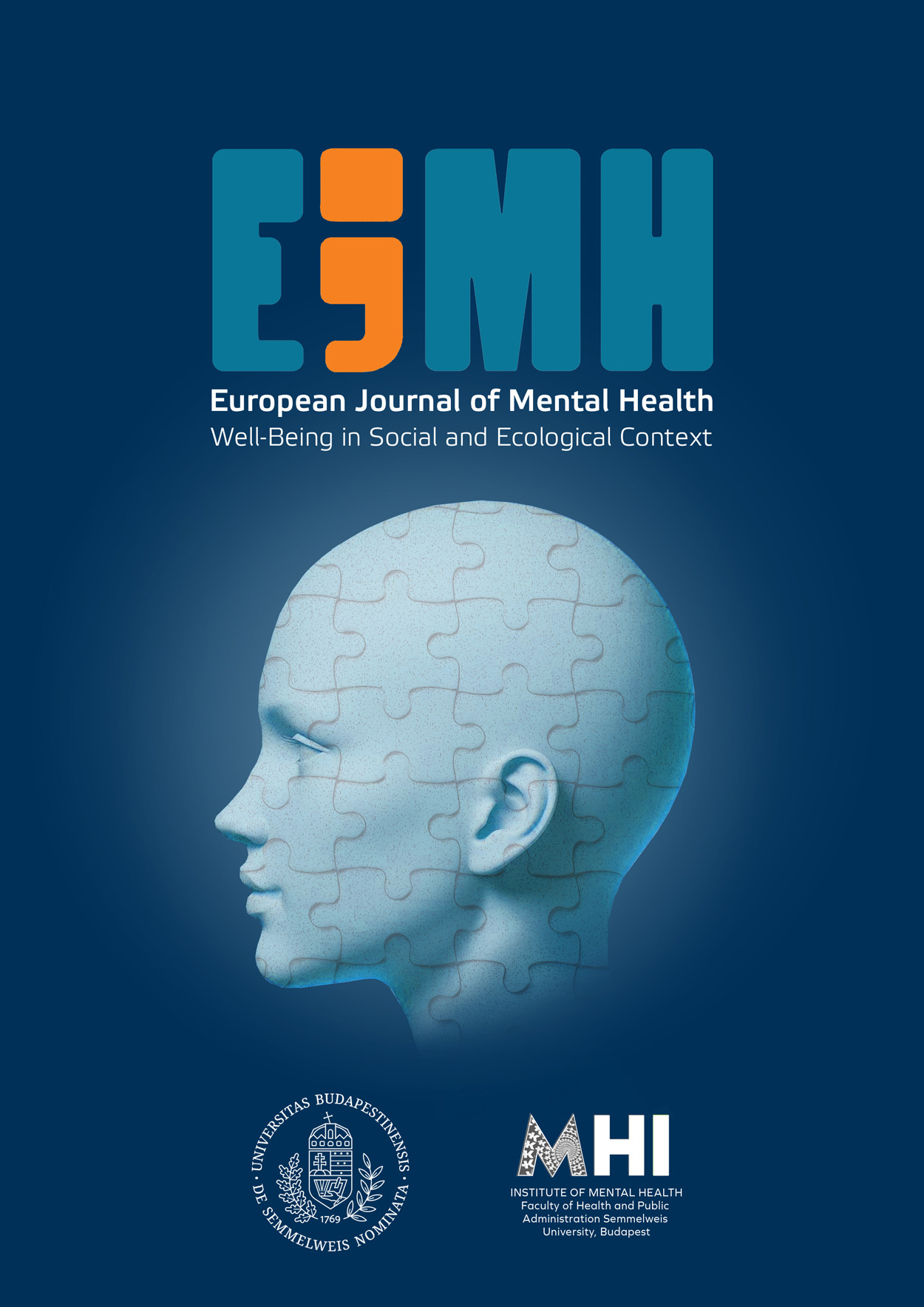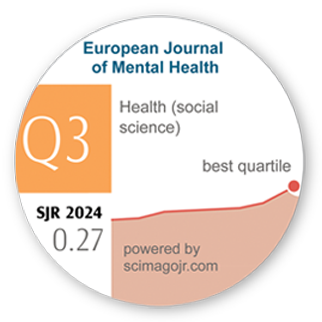Early Intervention Strategies for Enhancing Attachment and Interaction in Families with Premature Infants: A Systematic Literature Review
DOI:
https://doi.org/10.5708/EJMH.20.2025.0047Keywords:
preterm infants, parent-infant interaction, attachment, early intervention, NICUAbstract
Introduction: Preterm birth poses significant risks to neonatal health and development, impacting parental roles and early bonding.
Aim: Our systematic review explores recent interventions aimed at enhancing parent-premature infant interactions and attachment, particularly in NICU settings.
Methods: Following PRISMA guidelines, articles published between 2010 and 2024 were searched across major databases. 19 English-language studies assessing interventions to promote bonding, attachment, and interaction with preterm infants met the final inclusion criteria for the systematic review after rigorous screening and bias assessment.
Results: The reviewed studies presented diverse interventions targeting parent-infant relationship. The interventions included kangaroo care, parent education, and psychological support, conducted predominantly in hospital settings. Positive outcomes were consistently reported in enhancing attachment, improving parental sensitivity, and reducing maternal anxiety and depression. Father involvement also showed beneficial impacts on attachment outcomes.
Conclusions: Early interventions can mitigate the risks threatening the development of prematurely born infants by fostering secure parent-infant attachments and enhancing parental competence. The findings underscore the clinical significance of integrating bonding-focused interventions into routine NICU care, emphasizing the role of both parents in supporting infant development. Future healthcare strategies should prioritize the early comprehensive support to optimize the long-term developmental outcomes in preterm infants.
References
Ainsworth, M. D. S. (1979). Infant–mother attachment. American Psychologist, 34(10), 932–937.
https://doi.org/10.1037/0003-066X.34.10.932
Als, H., & Brazelton, T. B. (1981). A new model of assessing behavioral organization in preterm and fullterm infants. Journal of the American Academy of Child Psychiatry, 20(2), 239–263.
https://doi.org/10.1016/S0002-7138(09)60987-0
Arhan, E., Gücüyener, K., Soysal, Ş., Şalvarlı, Ş., Gürses, M. A., Serdaroğlu, A., Demir, E., Ergenekon, E., Türkyılmaz, C., Önal, E., Koç, E., & Atalay, Y. (2017). Regional brain volume reduction and cognitive outcomes in preterm children at low risk at 9 years of age. Child’s Nervous System, 33, 1317–1326.
https://doi.org/10.1007/s00381-017-3421-2
Axford, S. B., Burnett, A. C., Seid, A. M., Anderson, P. J., Waterland, J. L., Gilchrist, C. P., Olsen, J. E., Nguyen, T.-N.-N., Doyle, L. W., & Cheong, J. L. Y. (2025). Risk factor effects on neurodevelopment at 2 years in very preterm children: A systematic review. Pediatrics, 155(6), Article e2024069565.
https://doi.org/10.1542/peds.2024-069565
Aylward, G. P., Pfeiffer, S. I., Wright, A., & Verhulst, S. J. (1989). Outcome studies of low birth weight infants published in the last decade: A metaanalysis. The Journal of Pediatrics, 115(4), 515–520.
https://doi.org/10.1016/S0022-3476(89)80273-2
Bakermans-Kranenburg, M. J., Lotz, A., Alyousefi-van Dijk, K., & van IJzendoorn, M. (2019). Birth of a father: Fathering in the first 1,000 days. Child Development Perspectives, 13(4), 247–253.
https://doi.org/10.1111/cdep.12347
Baldoni, F., Ancora, G., & Latour, J. M. (2021). Being the father of a preterm-born child: Contemporary research and recommendations for NICU staff. Frontiers in Pediatrics, 9, Article 724992.
https://doi.org/10.3389/fped.2021.724992
Beebe, B., Myers, M. M., Lee, S. H., Lange, A., Ewing, J., Rubinchik, N., Andrews, H., Austin, J., Hane, A., Margolis, A. E., Hofer, M., Ludwig, R. J., & Welch, M. G. (2018). Family nurture intervention for preterm infants facilitates positive mother–infant face-to-face engagement at 4 months. Developmental Psychology, 54(11), 2016–2031.
https://doi.org/10.1037/dev0000557
Behboodi, S., Chaimani, A., Benhammou, V., Twilhaar, E. S., Johnson, S., Zeitlin, J., & Sentenac, M. (2025). Trends over time in cognitive outcomes of children born very preterm: A systematic review and meta-analysis. JAMA Pediatrics, 179(10), 1074–1081.
https://doi.org/10.1001/jamapediatrics.2025.2221
Behrman, R. E., & Butler, A. S. (Eds.). (2007). Preterm birth: Causes, consequences, and prevention. Institute of Medicine (US) Committee on Understanding Premature Birth and Assuring Healthy Outcomes; National Academies Press.
Bowlby, J. (1969). Attachment and loss: Vol. 1. Attachment. Basic Books.
Bozzette, M. (2007). A review of research on premature infant–mother interaction. Newborn and Infant Nursing Reviews, 7(1), 49–55.
https://doi.org/10.1053/j.nainr.2006.12.002
Brandon, D. H., Tully, K. P., Silva, S. G., Malcolm, W. F., Murtha, A. P., Turner, B. S., & Holditch‐Davis, D. (2011). Emotional responses of mothers of late‐preterm and term infants. Journal of Obstetric, Gynecologic, & Neonatal Nursing, 40(6), 719–731.
https://doi.org/10.1111/j.1552-6909.2011.01290.x
Breeman, L. D., Jaekel, J., Baumann, N., Bartmann, P., & Wolke, D. (2015). Preterm cognitive function into adulthood. Pediatrics, 136(3), 415–423.
https://doi.org/10.1542/peds.2015-0608
Brown, G. L., Mangelsdorf, S. C., & Neff, C. (2012). Father involvement, paternal sensitivity, and father–child attachment security in the first three years. Journal of Family Psychology, 26(3), 421–430.
https://doi.org/10.1037/a0027836
Chavan, A., Paul, N., Manerkar, S., Krishna DSN, A., Gupta, A., Sahu, T. K., Kalathingal, T., Krishna, V. V., & Mondkar, J. (2024). Impact of kangaroo father care in stable very low birth weight infants on father-infant bonding. Journal of Neonatal Nursing, 30(3), 293–296.
https://doi.org/10.1016/j.jnn.2023.10.012
Cho, Y., Hirose, T., Tomita, N., Shirakawa, S., Murase, K., Komoto, K., Nagayoshi, M., Okamitsu, M., & Omori, T. (2013). Infant mental health intervention for preterm infants in Japan: Promotions of maternal mental health, mother–infant interactions, and social support by providing continuous home visits until the corrected infant age of 12 months. Infant Mental Health Journal, 34(1), 47–59.
https://doi.org/10.1002/imhj.21352
Ding, L., Huang, J., Yan, X., Zhong, G., Yu, Z., Liu, D., & Wu, B. (2025). A comprehensive benchmark of very preterm and extremely preterm infant care in Shenzhen: Insights from the triple aim framework. Italian Journal of Pediatrics, 51, Article 186.
https://doi.org/10.1186/s13052-025-02043-2
Doyle, L. W., Cheong, J. L. Y., Burnett, A., Roberts, G., Lee, K. J., Anderson, P. J., & Victorian Infant Collaborative Study Group. (2015). Biological and social influences on outcomes of extreme-preterm/low-birth weight adolescents. Pediatrics, 136(6), e1513–e1520.
https://doi.org/10.1542/peds.2015-2006
Ettenberger, M., Bieleninik, L., Epstein, S., & Elefant, C. (2021). Defining attachment and bonding: Overlaps, differences and implications for music therapy clinical practice and research in the neonatal intensive care unit (NICU). International Journal of Environmental Research and Public Health, 18(4), Article 1733.
https://doi.org/10.3390/ijerph18041733
Evans, T., Whittingham, K., Sanders, M., Colditz, P., & Boyd, R. N. (2014). Are parenting interventions effective in improving the relationship between mothers and their preterm infants? Infant Behavior and Development, 37(2), 131–154.
https://doi.org/10.1016/j.infbeh.2013.12.009
García, H., Villasis-Keever, M. A., Zavala-Vargas, G., Bravo-Ortiz, J. C., Pérez-Méndez, A., & Escamilla-Núñez, A. (2024). Global prevalence and severity of retinopathy of prematurity over the last four decades (1985–2021): A systematic review and meta-analysis. Archives of Medical Research, 55(2), Article 102967.
https://doi.org/10.1016/j.arcmed.2024.102967
Ghetti, C. M., Gaden, T. S., Bieleninik, Ł., Kvestad, I., Assmus, J., Stordal, A. S., Aristizabal Sanchez, L. F., Arnon, S., Dulsrud, J., Elefant, C., Epstein, S., Ettenberger, M., Glosli, H., Konieczna-Nowak, L., Lichtensztejn, M., Lindvall, M. W., Mangersnes, J., Murcia Fernández, L. D., Røed, C. J., … Gold, C. (2023). Effect of music therapy on parent-infant bonding among infants born preterm: A randomized clinical trial. JAMA Network Open, 6(5), Article e2315750.
https://doi.org/10.1001/jamanetworkopen.2023.15750
Gondwe, K. W., & Holditch-Davis, D. (2015). Posttraumatic stress symptoms in mothers of preterm infants. International Journal of Africa Nursing Sciences, 3, 8–17.
https://doi.org/10.1016/j.ijans.2015.05.002
Hadders-Algra, M. (2005). Prematurity and low birthweight. In B. Hopkins (Ed.), The Cambridge encyclopedia of child development (pp. 442–447). Cambridge University Press.
Halford, W. K., & Petch, J. (2010). Couple psychoeducation for new parents: Observed and potential effects on parenting. Clinical Child and Family Psychology Review, 13, 164–180.
https://doi.org/10.1007/s10567-010-0066-z
Hendy, A., El-Sayed, S., Bakry, S., Mohammed, S. M., Mohamed, H., Abdelkawy, A., Hassani, R., Abouelela, M. A., & Sayed, S. (2024). The stress levels of premature infants’ parents and related factors in NICU. SAGE Open Nursing, 10, Article 23779608241231172.
https://doi.org/10.1177/23779608241231172
Heo, Y. J., & Oh, W.-O. (2019). The effectiveness of a parent participation improvement program for parents on partnership, attachment, and infant growth in a neonatal intensive care unit: A randomized controlled trial. International Journal of Nursing Studies, 95, 19–27.
https://doi.org/10.1016/j.ijnurstu.2019.03.018
Hoffenkamp, H. N., Tooten, A., Hall, R. A. S., Braeken, J., Eliëns, M. P. J., Vingerhoets, A. J. J. M., & van Bakel, H. J. A. (2015). Effectiveness of hospital-based video interaction guidance on parental interactive behavior, bonding, and stress after preterm birth: A randomized controlled trial. Journal of Consulting and Clinical Psychology, 83(2), 416–429.
https://doi.org/10.1037/a0038401
Ionio, C., Ciuffo, G., Colombo, C., Melani, O., Figlino, M. F., Landoni, M., Castoldi, F., Cavigioli, F., & Lista, G. (2024). Preterm birth and maternal mood states: What is the impact on bonding? Pediatric Reports, 16(1), 35–45.
https://doi.org/10.3390/pediatric16010004
Jaekel, J., Pluess, M., Belsky, J., & Wolke, D. (2015). Effects of maternal sensitivity on low birth weight children’s academic achievement: A test of differential susceptibility versus diathesis stress. Journal of Child Psychology and Psychiatry, 56(6), 693–701.
https://doi.org/10.1111/jcpp.12331
Jafarzadeh, Z. A., Maghsoudi, J., Barekatain, B., & Marofi, M. (2019). Effect of telenursing on attachment and stress in mothers of preterm infants. Iranian Journal of Neonatology, 10(1), 65–71.
https://doi.org/10.22038/ijn.2018.29890.1406
Jurišová, E., Ráczová, L., Zaťková, M., & Romanová, M. (2025). Cognitive, language, and motor developmental patterns of extremely preterm children up to 2 years of age: A descriptive approach. Frontiers in Psychology, 16, Article 1599390.
https://doi.org/10.3389/fpsyg.2025.1599390
Kadiroğlu, T., & Güdücü Tüfekci, F. (2022). Effect of infant care training on maternal bonding, motherhood self-efficacy, and self-confidence in mothers of preterm newborns. Maternal and Child Health Journal, 26, 131–138.
https://doi.org/10.1007/s10995-021-03287-0
Khoramirad, A., Taheri, L., Eskandari, N., & Abedini, Z. (2024). Effect of mindfulness-based neurodevelopmental care on infant outcomes in NICU. Journal of Neonatal Nursing, 30(3), 237–242.
https://doi.org/10.1016/j.jnn.2023.10.001
Kim, A. R., Kim, S.-Y., & Yun, J. E. (2020). Attachment and relationship-based interventions for families during neonatal intensive care hospitalization: A study protocol for a systematic review and meta-analysis. Systematic Reviews, 9, Article 61.
https://doi.org/10.1186/s13643-020-01331-8
Kim, S.-Y., & Kim, A. R. (2022). Attachment- and relationship-based interventions during NICU hospitalization for families with preterm/low-birth weight infants: A systematic review of RCT data. International Journal of Environmental Research and Public Health, 19(3), Article 1126.
https://doi.org/10.3390/ijerph19031126
Klaus, M. H., & Kennell, J. H. (1976). Maternal-infant bonding: The impact of early separation or loss on family development. Mosby.
Korja, R., Latva, R., & Lehtonen, L. (2012). The effects of preterm birth on mother–infant interaction and attachment during the infant’s first two years. Acta Obstetricia et Gynecologica Scandinavica, 91(2), 164–173.
https://doi.org/10.1111/j.1600-0412.2011.01304.x
Kostilainen, K., Mikkola, K., Erkkilä, J., & Huotilainen, M. (2020). Effects of maternal singing during kangaroo care on maternal anxiety, wellbeing, and mother–infant relationship after preterm birth: A mixed methods study. Nordic Journal of Music Therapy, 30(4), 357–376.
https://doi.org/10.1080/08098131.2020.1837210
Kurt, F. Y., Kucukoglu, S., Ozdemir, A. A., & Ozcan, Z. (2020). The effect of kangaroo care on maternal attachment in preterm infants. Nigerian Journal of Clinical Practice, 23(1), 26–32.
https://doi.org/10.4103/njcp.njcp_143_18
Lamb, M. E. (2002). Infant–father attachments and their impact on child development. In N. J. Cabrera, C.S. Tamis-Lemonda (Eds.), Handbook of father involvement. Routledge.
Lionetti, F., Sperati, A., Spinelli, M., Dellagiulia, A., Fasolo, M., & Pluess, M. (2025). Exploring preterm birth and low birth weight as environmental sensitivity factors: A scoping review of socio-emotional and cognitive developmental outcomes. Neuroscience & Biobehavioral Reviews, 175, Article 106216.
https://doi.org/10.1016/j.neubiorev.2025.106216
Meijssen, D., Wolf, M.-J., Koldewijn, K., Houtzager, B. A., van Wassenaer, A., Tronick, E., Kok, J., & van Baar, A. (2010). The effect of the Infant Behavioral Assessment and Intervention Program on mother–infant interaction after very preterm birth. Journal of Child Psychology and Psychiatry, 51(11), 1287–1295.
https://doi.org/10.1111/j.1469-7610.2010.02237.x
Ohuma, E. O., Moller, A.-B., Bradley, E., Chakwera, S., Hussain-Alkhateeb, L., Lewin, A., Okwaraji, Y. B., Mahanani, W. R., White Johansson, E., Lavin, T., Estevez Fernandez, D., Gatica Domínguez, G., de Costa, A., Cresswell, J. A., Krasevec, J., Lawn, J. E., Blencowe, H., Requejo, J., & Moran, A. C. (2023). National, regional, and global estimates of preterm birth in 2020, with trends from 2010: A systematic analysis. The Lancet, 402(10409), 1261–1271.
https://doi.org/10.1016/S0140-6736(23)00878-4
O’Meagher, S., Kemp, N., Norris, K., Anderson, P., & Skilbeck, C. (2017). Risk factors for executive function difficulties in preschool and early school-age preterm children. Acta Paediatrica, 106(9), 1468–1473.
https://doi.org/10.1111/apa.13915
Pace, C. C., Spittle, A. J., Molesworth, C. M.-L., Lee, K. J., Northam, E. A., Cheong, J. L. Y., Davis, P. G., Doyle, L. W., Treyvaud, K., & Anderson, P. J. (2016). Evolution of depression and anxiety symptoms in parents of very preterm infants during the newborn period. JAMA Pediatrics, 170(9), 863–870.
https://doi.org/10.1001/jamapediatrics.2016.0810
Posada, G., & Kaloustian, G. (2010). Attachment in infancy. In J. G. Bremner & T. D. Wachs (Eds.), The Wiley-Blackwell handbook of infant development: Vol.1. (2nd ed., pp. 483–509). Blackwell Publishing.
https://doi.org/10.1002/9781444327564.ch16
Potharst, E. S., Houtzager, B. A., van Sonderen, L., Tamminga, P., Kok, J. H., Last, B. F., & van Wassenaer, A. G. (2012). Prediction of cognitive abilities at the age of 5 years using developmental follow-up assessments at the age of 2 and 3 years in very preterm children. Developmental Medicine and Child Neurology, 54(3), 240–246.
https://doi.org/10.1111/j.1469-8749.2011.04181.x
Ravn, I. H., Smith, L., Lindemann, R., Smeby, N. A., Kyno, N. M., Bunch, E. H., & Sandvik, L. (2011). Effect of early intervention on social interaction between mothers and preterm infants at 12 months of age: A randomized controlled trial. Infant Behavior and Development, 34(2), 215–225.
https://doi.org/10.1016/j.infbeh.2010.11.004
Reis, A. B. R., de Mello, R. R., Morsch, D. S., Meio, M. D. B. B., & da Silva, K. S. (2012). Mental performance of very low birth weight preterm infants: Assessment of stability in the first two years of life and factors associated with mental performance. Revista Brasileira de Epidemiologia, 15(1), 13–24.
https://doi.org/10.1590/s1415-790x2012000100002
Sameroff, A. (2009). The transactional model. In A. Sameroff (Ed.), The transactional model of development: How children and contexts shape each other (pp. 3–21). American Psychological Association.
https://doi.org/10.1037/11877-001
Seiiedi-Biarag, L., Mirghafourvand, M., Esmaeilpour, K., & Hasanpour, S. (2021). A randomized controlled clinical trial of the effect of supportive counseling on mental health in Iranian mothers of premature infants. BMC Pregnancy and Childbirth, 21, Article 6.
https://doi.org/10.1186/s12884-020-03502-w
Shaw, R. J., Givrad, S., Poe, C., Loi, E. C., Hoge, M. K., & Scala, M. (2023). Neurodevelopmental, mental health, and parenting issues in preterm infants. Children, 10(9), Article 1565.
https://doi.org/10.3390/children10091565
Shoghi, M., Sohrabi, S., & Rasouli, M. (2018). The effects of massage by mothers on mother-infant attachment. Alternative Therapies in Heatlh and Medicine, 24(3), 34–39.
Siva, N., Nayak, B. S., Lewis, L. E. S., Velayudhan, B., & Noronha, J. A. (2025). Intervention strategies to enhance early mother-infant interaction at NICU: A systematic review. Journal of Neonatal Nursing, 31(3), Article 101671.
https://doi.org/10.1016/j.jnn.2025.101671
Treyvaud, K. (2014). Parent and family outcomes following very preterm or very low birth weight birth: A review. Seminars in Fetal and Neonatal Medicine, 19(2), 131–135.
https://doi.org/10.1016/j.siny.2013.10.008
Twohig, A., Murphy, J. F., McCarthy, A., Segurado, R., Underdown, A., Smyke, A., McNicholas, F., & Molloy, E. J. (2021). The preterm infant–parent programme for attachment—PIPPA study: A randomised controlled trial. Pediatric Research, 90, 617–624.
https://doi.org/10.1038/s41390-020-01262-z
Vahdati, M., Mohammadizadeh, M., & Talakoub, S. (2017). Effect of kangaroo care combined with music on the mother–premature neonate attachment: A randomized controlled trial. Iranian Journal of Nursing and Midwifery Research, 22(5), 403–407.
https://doi.org/10.4103/ijnmr.IJNMR_50_16
White-Traut, R., Norr, K. F., Fabiyi, C., Rankin, K. M., Li, Z., & Liu, L. (2013). Mother–infant interaction improves with a developmental intervention for mother–preterm infant dyads. Infant Behavior and Development, 36(4), 694–706.
https://doi.org/10.1016/j.infbeh.2013.07.004
Wolke, D., Eryigit-Madzwamuse, S., & Gutbrod, T. (2014). Very preterm/very low birthweight infants’ attachment: Infant and maternal characteristics. Archives of Disease in Childhood – Fetal and Neonatal Edition, 99, F70–F75.
https://doi.org/10.1136/archdischild-2013-303788
World Health Organization. (2023). Born too soon: Decade of action on preterm birth (1st ed.). World Health Organization.
Yan, C., Gong, X., Luo, H., Liu, Y., Lin, Y., Weng, B., & Cai, C. (2024). Impact of implementation of 2019 European respiratory distress syndrome guidelines on bronchopulmonary dysplasia in very preterm infants. Italian Journal of Pediatrics, 50, Article 178.
https://doi.org/10.1186/s13052-024-01752-4
Yerlikaya Oral, E., & Karaçetin, G. (2024). Preterm birth’s effects on attachment. Cam and Sakura Medical Journal, 4(2), 39–47.
https://doi.org/10.4274/csmedj.galenos.2024.2024-7-1
Yu, N. K. K., Shum, K. K.-M., Lam, Y. Y., Kwan, Q. K. L., Ng, S. Y. P., & Chan, N. T. T. (2022). Sensitivity training for mothers with premature infants: A randomized controlled trial. Journal of Pediatric Psychology, 47(10), 1167–1184.
https://doi.org/10.1093/jpepsy/jsac051






